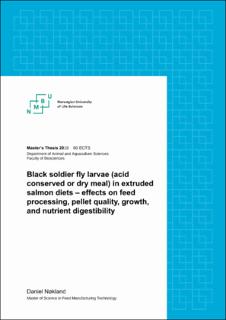| dc.description.abstract | The study was designed to investigate the effect of full fat black soldier fly larvae (BSFL) (Hermetia illucens L.) in diets for Atlantic salmon (Salmo salar) with emphasis on extrusion processing parameters, pellet quality, digestibility and growth. BSFL was substituted on a protein level in commercial like salmon diet except wheat flour and vitamin/minerals to maintain similar relationship between protein and energy, and protein and starch. BSFL was added as a dried insect meal or a formic acid conserved insect paste. The control diet, IMC, served as the control for increasing inclusion of insect meal (6.25%, 12.5 and 25%) and, IPC, as the control diet including formic acid for the increasing inclusion of insect paste diets (3,7% and 6,7%). Challenges during extrusion were observed with the increasing insect inclusions, due to increased lipid content in the mash. This resulted in changes in extrusion processing shown as, decreased specific mechanical energy (SME), temperature, torque, die pressure and residence time. This provided decreased cooking of the product which led to decrease pellet quality measurement i.e. hardness, durability, expansion and water stability. Formic acid addition in IPC reduced palatability of the diet, which reduced feed intake, thus reduced growth. Digestibility of nutrients were however, elevated compared to the other diets. Growth stagnated with the highest inclusion of insect meal and paste as a result of significant reduction of protein and lipid digestibility with increasing insect product inclusion. This was thought to be a function of chitin, hindering availability of nutrient in the gastro intestinal tract for the Atlantic salmon. Reduced protein digestibility could also be influenced by the nitrogen content in chitin, which has a low digestibility in Atlantic salmon. The digestibility of starch was, however, improved with increasing inclusion of insect meal. This was believed to be a function of the balance in water holding capacity (WHC) of the ingredients resulting in increased availability in the Atlantic salmon. | en_US |

